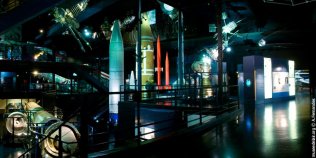This area dedicated to space exploration at the Air and Space museum Paris Le Bourget relates the passionate history of space adventurers and technologies that allowed them to write the history of space flight.
 Models of rockets, satellites and spacecraft (Spoutnik, Voyager and an authentic Soyouz spaceship), including a large choice of audiovisual clips, allowing us to better understand the history and stakes involved on the conquest of space in a hall covering 2,500 m2.
Models of rockets, satellites and spacecraft (Spoutnik, Voyager and an authentic Soyouz spaceship), including a large choice of audiovisual clips, allowing us to better understand the history and stakes involved on the conquest of space in a hall covering 2,500 m2.
Large-scale animated presentations show the trajectory of the space rocket Ariane 5 and mission Apollo 11. Discover the big names in the conquest of space : the father of modern astronautics Constantin Tsiolkovski, the astronaut Jean-Loup Chrétien, etc.
Don't miss our english spoken heritage visits!
On March 6, 1998, the Sputnik scale 1 model was installed at the Musée de l'Air at Le Bourget. It was the first artificial satellite to orbit the Earth. The model is on display in the Hall de l'Espace, where you can hear its famous "beep-beep"!
On July 7, 1995, Helios 1A, France's first intelligence satellite, was launched into orbit on the 75th flight of Ariane. The Musée de l'Air et de l'Espace at Le Bourget houses the Ariane 40 fairing that launched the satellite.
On February 22, 1986, Ariane 1 launches the SPOT-1 satellite (Satellite Pour l'Observation de la Terre), the earth is now observed by a French satellite.
On February 10, 1983, the model of the "Tiberius" rocket leaves the Meudon site for the first floor of the Hall de l'Espace at the Musée de l'air in Le Bourget.
On June 24 1982, Jean-Loup Chrétien becomes the 1st Frenchman in space. He took off from Baikonur on the First Manned Flight mission. Today, the Musée de l'Air conserves the Soyuz T-6 capsule and Jean-Loup Chrétien's space suit from this mission.
On March 31, 1966, the Soviet probe "Luna10" was launched from the Baikonur cosmodrome (Kazakhstan). A replica is on display in the Hall de l'Espace at the Musée de l'air et de l'espace in Le Bourget.
On February 3, 1966, the Soviet probe "Luna 9" landed softly on the Moon at a place called Ocean of Storms, transmitting the first images of the lunar surface with a resolution of just a few millimeters.